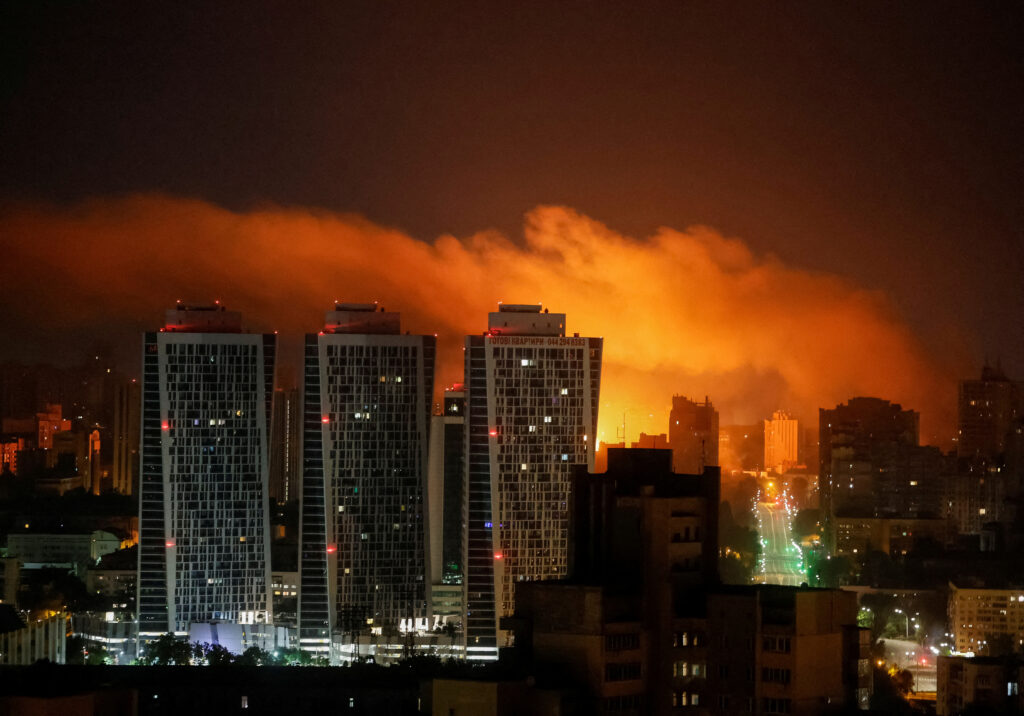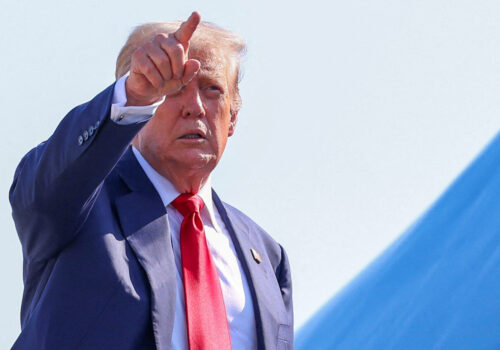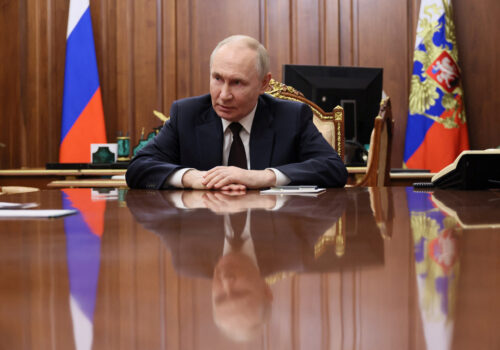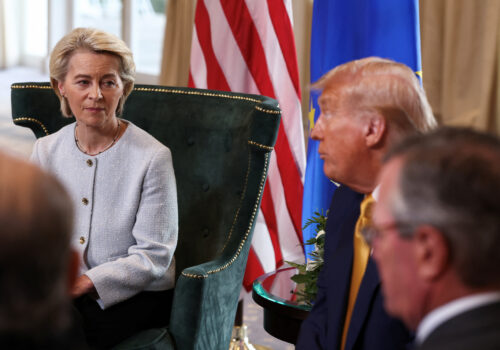The startling swarms of drones Russia and Ukraine are fielding against each other—an arms and technology race with lethal consequences—underscores how unprepared Europe is for modern warfare. That makes the twenty-seven European Union (EU) member states, particularly those neighboring Russia, vulnerable to a rapidly innovating and battle-tested Russian military.
Andrius Kubilius, the EU’s first-ever commissioner for defense and space, is tracking this escalating drone warfare with a sense of concern and urgency. On a visit to Washington last week, he shared with me what Europe is learning about modern warfare from Ukraine—and how the EU intends to respond to those lessons.
Stronger than in February 2022
“The success of the [Russian] drones in recent months,” write Charles Clover and Christopher Miller in the Financial Times, “demonstrates how cheap mass can overwhelm even sophisticated and layered air defences, and has shown Moscow’s ability to rapidly adapt fighting techniques to stretch Kyiv’s resources.”
What’s most worrisome is that Russia’s rapid advances are outpacing Ukraine’s ability to counter them. Russian forces are flying drones faster, increasing the size of the swarms, and flying the weapons at higher altitudes. That has put Russia’s drones out of range of the truck-mounted machine guns Ukraine had previously used so effectively.
European intelligence services estimate that for these reasons and many others, Russia will be fully prepared to test NATO Article 5 security guarantees for the EU’s Baltic members in the next three to five years. (My own view is that it could be sooner.)
“We are not ready,” Kubilius tells me. “Day X is coming, and we need to see the picture clearly, the very real threat from [Russian President Vladimir] Putin” and his battle-hardened Russian army, now equipped with millions of drones. Despite more than a million casualties and significant material losses, the Russian military is stronger and more capable than when it invaded Ukraine in February 2022, Kubilius says.
Accelerating the European effort
It’s Kubilius’s job—together with NATO and EU member states—to ramp up defense preparedness with a life-and-death urgency that will test the EU’s slow-moving bureaucracy and regulatory procedures. Only the COVID-19 pandemic was similar in the challenge it posed to EU structures; the union responded well then, but the pandemic also revealed weaknesses in managing supply chains and in effective coordination among member states.
The good news is that European countries have committed to spend more than ever before on defense, prompted both by Russia’s increasing threat and a growing reluctance by the Trump administration to continue to carry so much of the European security burden.
Kubilius estimates that the twenty-seven EU member states will spend around €4.2 trillion on defense in the seven years between 2028 and 2035—or about €600 billion annually. That will come both because of new EU commitments and European countries’ promises at the NATO Summit in The Hague in June to increase their annual defense and defense-related spending to 5 percent of gross domestic product by 2035.
The bad news is that those commitments and defense capabilities are needed now in Ukraine. Even the most optimistic spending scenarios aren’t fast enough to address the threat.
To accelerate the EU’s military modernization, the EU will roll out a plan this autumn—something called BraveTech EU, which will aim to integrate the battlefield lessons learned in Ukraine with Europe’s best thinking.
At the same time, Kubilius and his team will begin assessing the first proposals for borrowing from a new €150 billion loan facility to jump-start EU-inspired defense industrial efforts. That will be part of an €800 billion effort over four years, with Kubilius seeing the EU as the body that incentivizes and galvanizes joint procurement, co-production, and industrial integration among member states, which remain in the lead on defense matters.
While making decisions on these projects, Kubilius intends to prioritize three lines of effort, with overlaps among them.
First, the EU will focus on projects that serve the capabilities targets that NATO leaders agreed to earlier this year. While the specific targets are classified, in general they focus on air and missile defense, long-range weapons, logistics, enhanced defense industrial capacity, robust supply chains, and new technologies. Kubilius speaks of “good, practical, formal, and informal” cooperation with the Alliance. “There’s no competition with NATO plans,” he says. “We are coming with added value.”
Second, the EU funds will go toward “strategic enablers,” an area where European countries now are most dependent on the United States. Those enablers include, but are not limited to, intelligence gathering from space-based assets, heavy airlift, and strategic communications.
Third, the EU will prioritize flagship projects that can only be achieved by two or more countries cooperatively and through joint procurement. One could imagine major projects in areas such as drone systems, drone counter-systems on the eastern front, joint air defense development, and long-range strike systems.
At the same time, the EU will also prioritize joint procurement and will explore financial solutions that would bring the increased funding to bear far more rapidly than currently envisioned.
Awakening the force for freedom
The EU intends both to learn from Ukraine and to integrate Kyiv in its own defense efforts. Ukraine obviously has the greatest experience in creating an environment where defense manufacturing and technological innovations can be implemented rapidly.
Kubilius spoke of his own experience visiting a drone-production facility in Ukraine, where the manufacturing coexisted with drone operators and engineers. The operators, many of whom were trained in the gaming industry, steered weapons to their targets, while engineers relentlessly updated the technology. Kubilius was told that Russian advances are making the drone technology obsolete every two or three months.
The rapid growth and development of the Ukrainian defense industry has helped the country compensate for less reliable US and insufficient European supply. Ukrainian President Volodymyr Zelenskyy has said that Ukraine now produces some 40 percent of the weapons it uses, and virtually all of its drones. Even so, its defense budget of roughly fifty billion dollars is a third the size of Russia’s. NATO Secretary General Mark Rutte estimates that Russia produces as much ammunition in three months as all of NATO does in a year.
What’s unfortunate is that the United States remains an ambiguous player regarding Ukraine at a moment when Europe has belatedly ramped up its defense spending and more clearly embraced Kyiv. Though there is good news, too: President Donald Trump recently agreed to keep US weapons flowing to Ukraine, though paid for by Europe. Beyond that, Zelenskyy said this past weekend that he had reached agreement with Trump on the sale of Ukrainian drones to the United States, a contract with potential value of ten billion dollars to thirty billion dollars. Zelenskyy said Ukraine is already working to relocate elements of its national weapons production abroad, with negotiations ongoing with Denmark, Norway, and Germany to establish joint manufacturing.
Even greater transatlantic common cause on military and financial support for Ukraine would make the United States and Europe an insurmountable rival for Moscow. This past weekend’s US-EU trade agreement has also raised greater hopes for defense cooperation. At the very least, European officials are hoping that any other US changes in weapons deliveries to Ukraine or European force posture come through a coordinated process and not by surprise.
When it comes to defense spending and production, Europe has been a “sleeping giant”—with nine times the gross domestic product of Russia—says one senior EU official, who was speaking on condition of anonymity. Optimists celebrate the awakening of this force for freedom, while pessimists worry that it may be too little and too late.
Says Kubilius: “We cannot ask Putin to postpone his plans.”
Frederick Kempe is president and chief executive officer of the Atlantic Council. You can follow him on X: @FredKempe.
This edition is part of Frederick Kempe’s Inflection Points newsletter, a column of dispatches from a world in transition. To receive this newsletter throughout the week, sign up here.
Further reading
Fri, Jul 25, 2025
Putin may be miscalculating Trump’s resolve on Ukraine
New Atlanticist By John E. Herbst
Recent days have seen a steady increase in US and Western support for Ukraine and a concomitant toughening of NATO policy toward Russia.
Thu, Jul 17, 2025
Time remains on Putin’s side. That must change.
New Atlanticist By Caroline Zier
The United States can take five specific actions now to disabuse the Russian president of the belief that he can simply play for time in Ukraine.
Sun, Jul 27, 2025
How big a deal is the new US-EU trade announcement?
Fast Thinking By
Our experts unpack the framework for a trade deal announced by US President Donald Trump and European Commission President Ursula von der Leyen on Sunday in Scotland.
Image: An explosion of a drone lights up the sky over the city during a Russian drone and missile strike, amid Russia's attack on Ukraine, in Kyiv, Ukraine July 10, 2025. REUTERS/Gleb Garanich




